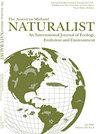俄勒冈斑点蛙(Rana pretiosa)从水生越冬地迁移:时间,持续时间和潜在的环境线索
IF 0.6
4区 环境科学与生态学
Q4 Agricultural and Biological Sciences
引用次数: 0
摘要
摘要相对而言,很少有北美无尾蜥蜴在水中越冬,关于它们从越冬栖息地到繁殖地的迁徙信息也很少。俄勒冈斑点蛙(Rana pretiosa)在早春繁殖迅速,通常在远离繁殖栖息地的地方过冬。在它们活动范围的山区,越冬和繁殖的栖息地可以冻结数月。在美国俄勒冈州中部喀斯喀特山脉附近的一个越冬湖泊,我们调查了红背沙鼠迁徙的时间、持续时间和潜在线索。在暖冬和长冬季节,雄性早在2月12日,雌性晚在4月4日。蛙类在一个低地红蛙种群中,水温低于与早期繁殖活动相关的水温。在漫长的冬季条件下,更高比例的青蛙在冰封前迁徙。移民在后来几年的迁徙中被暂时压缩了。与低地种群相比,这种迁徙“匆忙”,以及在寒冷温度下迁徙和改变迁徙时间的能力,可能有助于山地r.p retiosa应对更冷、更多变的春季环境。本文章由计算机程序翻译,如有差异,请以英文原文为准。
Oregon Spotted Frog (Rana pretiosa) Migration from an Aquatic Overwintering Site: Timing, Duration, and Potential Environmental Cues
Abstract. Relatively few North American anurans overwinter in water and information is sparse on their movement from overwintering habitat to breeding sites. Oregon spotted frogs (Rana pretiosa) breed explosively in early spring and often overwinter submerged at sites that are distanced from breeding habitats. In montane parts of their range, wintering and breeding habitats can remain frozen for months. We investigated timing, duration, and potential cues for R. pretiosa migrations from a wintering lake near the Cascade Mountains in central Oregon, U.S.A. First and median migrant males moved slightly earlier than females. Onset of migration was as early as February 12 (males) and as late as April 4 (females) in years of mild and extended winters, respectively. Frogs were active at water temperatures below those associated with early breeding activities in one lowland R. pretiosa population. Higher proportions of frogs migrated before ice-out in years of prolonged winter conditions. Migrations were temporally compressed in years of later movement. This migration ‘rush’, along with the ability to move at cold temperatures and to vary timing of migrations likely helps montane R. pretiosa deal with colder and more variable spring conditions than lowland populations.
求助全文
通过发布文献求助,成功后即可免费获取论文全文。
去求助
来源期刊

American Midland Naturalist
环境科学-生态学
CiteScore
1.20
自引率
0.00%
发文量
38
审稿时长
18-36 weeks
期刊介绍:
The American Midland Naturalist has been published for 90 years by the University of Notre Dame. The connotations of Midland and Naturalist have broadened and its geographic coverage now includes North America with occasional articles from other continents. The old image of naturalist has changed and the journal publishes what Charles Elton aptly termed "scientific natural history" including field and experimental biology. Its significance and breadth of coverage are evident in that the American Midland Naturalist is among the most frequently cited journals in publications on ecology, mammalogy, herpetology, ornithology, ichthyology, parasitology, aquatic and invertebrate biology and other biological disciplines.
 求助内容:
求助内容: 应助结果提醒方式:
应助结果提醒方式:


